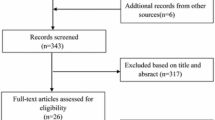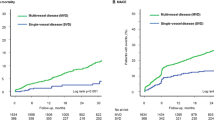Abstract
The therapeutic effects of reperfusion strategies with complete revascularization (CR) or incomplete revascularization (IR) in non-ST segment myocardial infarction (NSTEMI) patients with multivessel disease (MVD) are controversial. In such patients, whether utilization of different generations of drug-eluting stents (DES) for IR or CR affect long-term major adverse cardiovascular events (MACE) is unknown. This study included 702 NSTEMI patients with MVD who received first-generation (1G) or second-generation (2G) DES. In multivariable analysis, chronic kidney disease, chronic total, 1G DES and IR were independent predictors of long-term MACE. In patients receiving 1G DES, no significant differences of MACE were observed between the IR and CR groups (39.1% vs. 36.2%, p = 0.854). However, in patients receiving 2G DES, significantly fewer MACE were observed in the CR group than in the IR group (3.7% vs. 10.2%, p = 0.002). Compared with patients receiving 1G DES for IR, those receiving 2G DES for IR and CR exhibited significantly lower risk of MACE (59% and 83% lower, respectively). CR could not provide clinical benefits over IR in NSTEMI patients with MVD receiving 1G DES. However, in patients receiving 2G DES, compared with IR, CR was associated with a lower risk of long-term MACE, which was mainly caused by low rates of non-TLR and any revascularization.


Similar content being viewed by others
References
Breeman A, Mercado N, Lenzen M, van den Brand MM, Harrington RA, Califf RM, Topol EJ, Simoons ML, Boersma E, Investigators P (2002) Characteristics, treatment and outcome of patients with non-ST-elevation acute coronary syndromes and multivessel coronary artery disease: observations from PURSUIT (platelet glycoprotein IIb/IIIa in unstable angina: receptor suppression using integrelin therapy). Cardiology 98:195–201
Authors/Task Force m, Windecker S, Kolh P, Alfonso F, Collet JP, Cremer J, Falk V, Filippatos G, Hamm C, Head SJ, Juni P, Kappetein AP, Kastrati A, Knuuti J, Landmesser U, Laufer G, Neumann FJ, Richter DJ, Schauerte P, Sousa Uva M, Stefanini GG, Taggart DP, Torracca L, Valgimigli M, Wijns W, Witkowski A (2014) 2014 ESC/EACTS Guidelines on myocardial revascularization: the Task Force on Myocardial Revascularization of the European Society of Cardiology (ESC) and the European Association for Cardio-Thoracic Surgery (EACTS)Developed with the special contribution of the European Association of Percutaneous Cardiovascular Interventions (EAPCI). Eur Heart J 35:2541–2619
Fihn SD, Blankenship JC, Alexander KP, Bittl JA, Byrne JG, Fletcher BJ, Fonarow GC, Lange RA, Levine GN, Maddox TM, Naidu SS, Ohman EM, Smith PK (2014) 2014 ACC/AHA/AATS/PCNA/SCAI/STS focused update of the guideline for the diagnosis and management of patients with stable ischemic heart disease: a report of the American College of Cardiology/American Heart Association Task Force on Practice Guidelines, and the American Association for Thoracic Surgery, Preventive Cardiovascular Nurses Association, Society for Cardiovascular Angiography and Interventions, and Society of Thoracic Surgeons. J Am Coll Cardiol 64:1929–1949
Pandey A, McGuire DK, de Lemos JA, Das SR, Berry JD, Brilakis ES, Banerjee S, Marso SP, Barsness GW, Simon DN, Roe M, Goyal A, Kosiborod M, Amsterdam EA, Kumbhani DJ (2016) Revascularization trends in patients with diabetes mellitus and multivessel coronary artery disease presenting with non-ST elevation myocardial infarction: insights from the national cardiovascular data registry acute coronary treatment and intervention outcomes network registry-get with the guidelines (NCDR ACTION Registry-GWTG). Circ Cardiovasc Qual Outcomes 9:197–205
Ahn JM, Park DW, Lee CW, Chang M, Cavalcante R, Sotomi Y, Onuma Y, Tenekecioglu E, Han M, Lee PH, Kang SJ, Lee SW, Kim YH, Park SW, Serruys PW, Park SJ (2017) Comparison of stenting versus bypass surgery according to the completeness of revascularization in severe coronary artery disease: patient-level pooled analysis of the SYNTAX, PRECOMBAT, and BEST trials. JACC Cardiovasc Interv 10:1415–1424
Brener SJ, Murphy SA, Gibson CM, DiBattiste PM, Demopoulos LA, Cannon CP, Aggrastat T-TITAw, Determine Cost of Therapy with an Invasive or Conservative Strategy-Thrombosis in Myocardial I (2002) Efficacy and safety of multivessel percutaneous revascularization and tirofiban therapy in patients with acute coronary syndromes. Am J Cardiol 90:631–633
Palmer ND, Causer JP, Ramsdale DR, Perry RA (2004) Effect of completeness of revascularization on clinical outcome in patients with multivessel disease presenting with unstable angina who undergo percutaneous coronary intervention. J Invasive Cardiol 16:185–188
Kim MC, Jeong MH, Ahn Y, Kim JH, Chae SC, Kim YJ, Hur SH, Seong IW, Hong TJ, Choi DH, Cho MC, Kim CJ, Seung KB, Chung WS, Jang YS, Cho SY, Rha SW, Bae JH, Cho JG, Park SJ, Korea Acute Myocardial Infarction Registry I (2011) What is optimal revascularization strategy in patients with multivessel coronary artery disease in non-ST-elevation myocardial infarction? Multivessel or culprit-only revascularization. Int J Cardiol 153:148–153
Lee HJ, Song YB, Hahn JY, Kim SM, Yang JH, Choi JH, Choi SH, Choi JH, Lee SH, Gwon HC (2011) Multivessel vs single-vessel revascularization in patients with non-ST-segment elevation acute coronary syndrome and multivessel disease in the drug-eluting stent era. Clin Cardiol 34:160–165
Onuma Y, Muramatsu T, Girasis C, Kukreja N, Garcia-Garcia HM, Daemen J, Gonzalo N, Piazza N, Einthoven J, van Domburg R, Serruys PW, Interventional cardiologists of the T (2013) Single-vessel or multivessel PCI in patients with multivessel disease presenting with non-ST-elevation acute coronary syndromes. EuroIntervention 9:916–922
Hassanin A, Brener SJ, Lansky AJ, Xu K, Stone GW (2015) Prognostic impact of multivessel versus culprit vessel only percutaneous intervention for patients with multivessel coronary artery disease presenting with acute coronary syndrome. EuroIntervention 11:293–300
Mariani J, Macchia A, De Abreu M, Gonzalez Villa Monte G, Tajer C (2016) Multivessel versus single vessel angioplasty in non-ST elevation acute coronary syndromes: a systematic review and metaanalysis. PLoS One 11:e0148756
De Luca G, Smits P, Hofma SH, Di Lorenzo E, Vlachojannis GJ, Van’t Hof AWJ, van Boven AJ, Kedhi E, Stone GW, Suryapranata H, Drug-Eluting Stent in Primary Angioplasty c (2017) Everolimus eluting stent vs first generation drug-eluting stent in primary angioplasty: a pooled patient-level meta-analysis of randomized trials. Int J Cardiol 244:121–127
Stone GW, Midei M, Newman W, Sanz M, Hermiller JB, Williams J, Farhat N, Caputo R, Xenopoulos N, Applegate R, Gordon P, White RM, Sudhir K, Cutlip DE, Petersen JL, Investigators SI (2009) Randomized comparison of everolimus-eluting and paclitaxel-eluting stents: two-year clinical follow-up from the Clinical Evaluation of the Xience V Everolimus Eluting Coronary Stent System in the Treatment of Patients with de novo Native Coronary Artery Lesions (SPIRIT) III trial. Circulation 119:680–686
Varenhorst C, Lindholm M, Sarno G, Olivecrona G, Jensen U, Nilsson J, Carlsson J, James S, Lagerqvist B (2018) Stent thrombosis rates the first year and beyond with new- and old-generation drug-eluting stents compared to bare metal stents. Clin Res Cardiol 107(9):816–823
Rodriguez AE, Santaera O, Larribau M, Sarmiento R, Haiek C, Del Pozo JF, Pavlovsky H, Rodriguez-Granillo AM, Investigators EI (2017) Second vs. first-generation drug-eluting stents in complex lesions subsets: 3 years’ follow-up of ERACI IV study. Miner Cardioangiol 65:81–90
Wanha W, Kawecki D, Roleder T, Morawiec B, Gladysz S, Kowalowka A, Jadczyk T, Adamus B, Pawlowski T, Smolka G, Kazmierski M, Ochala A, Nowalany-Kozielska E, Wojakowski W (2017) Second-generation drug-eluting stents in the elderly patients with acute coronary syndrome: the in-hospital and 12-month follow-up of the all-comer registry. Aging Clin Exp Res 29:885–893
Kawecki D, Morawiec B, Dola J, Wanha W, Smolka G, Pluta A, Marcinkiewicz K, Ochala A, Nowalany-Kozielska E, Wojakowski W (2016) First- versus second-generation drug-eluting stents in acute coronary syndromes (Katowice-Zabrze registry). Arq Bras Cardiol 106:373–381
Kawecki D, Morawiec B, Dola J, Wanha W, Smolka G, Pluta A, Marcinkiewicz K, Ochala A, Nowalany-Kozielska E, Wojakowski W (2015) Comparison of first- and second-generation drug-eluting stents in an all-comer population of patients with diabetes mellitus (from Katowice-Zabrze registry). Med Sci Monit 21:3261–3269
Galloe AM, Kelbaek H, Thuesen L, Hansen HS, Ravkilde J, Hansen PR, Christiansen EH, Abildgaard U, Stephansen G, Lassen JF, Engstrom T, Jensen JS, Jeppesen JL, Bligaard N, Investigators SOI (2017) 10-Year clinical outcome after randomization to treatment by sirolimus- or paclitaxel-eluting coronary stents. J Am Coll Cardiol 69:616–624
Jensen LO, Thayssen P, Christiansen EH, Maeng M, Ravkilde J, Hansen KN, Hansen HS, Krusell L, Kaltoft A, Tilsted HH, Berencsi K, Junker A, Lassen JF, Investigators SOI (2016) Safety and efficacy of everolimus- versus sirolimus-eluting stents: 5-year results from SORT OUT IV. J Am Coll Cardiol 67:751–762
Kobayashi N, Ito Y, Yamawaki M, Araki M, Sakai T, Obokata M, Sakamoto Y, Mori S, Tsutsumi M, Nauchi M, Honda Y, Tokuda T, Makino K, Shirai S, Hirano K (2018) Differences between first-generation and second-generation drug-eluting stent regarding in-stent neoatherosclerosis characteristics: an optical coherence tomography analysis. Int J Cardiovasc Imaging. https://doi.org/10.1007/s10554-018-1375-4
Stone GW, McLaurin BT, Cox DA, Bertrand ME, Lincoff AM, Moses JW, White HD, Pocock SJ, Ware JH, Feit F, Colombo A, Aylward PE, Cequier AR, Darius H, Desmet W, Ebrahimi R, Hamon M, Rasmussen LH, Rupprecht HJ, Hoekstra J, Mehran R, Ohman EM, Investigators A (2006) Bivalirudin for patients with acute coronary syndromes. N Engl J Med 355:2203–2216
Wiviott SD, Braunwald E, McCabe CH, Montalescot G, Ruzyllo W, Gottlieb S, Neumann FJ, Ardissino D, De Servi S, Murphy SA, Riesmeyer J, Weerakkody G, Gibson CM, Antman EM, Investigators T-T (2007) Prasugrel versus clopidogrel in patients with acute coronary syndromes. N Engl J Med 357:2001–2015
Wallentin L, Becker RC, Budaj A, Cannon CP, Emanuelsson H, Held C, Horrow J, Husted S, James S, Katus H, Mahaffey KW, Scirica BM, Skene A, Steg PG, Storey RF, Harrington RA, Freij A, Thorsen M, Investigators P (2009) Ticagrelor versus clopidogrel in patients with acute coronary syndromes. N Engl J Med 361:1045–1057
Acknowledgements
This work was supported by Chang Gung Medical Foundation, Grant no. CORPG 3C0162 & 3G0281.
Author information
Authors and Affiliations
Corresponding author
Ethics declarations
Conflict of interest
The author(s) declare that they have no competing interests.
Rights and permissions
About this article
Cite this article
Hsieh, MJ., Chen, CC., Lee, CH. et al. Complete and incomplete revascularization in non-ST segment myocardial infarction with multivessel disease: long-term outcomes of first- and second-generation drug-eluting stents. Heart Vessels 34, 251–258 (2019). https://doi.org/10.1007/s00380-018-1252-z
Received:
Accepted:
Published:
Issue Date:
DOI: https://doi.org/10.1007/s00380-018-1252-z




